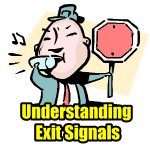The Bollinger Bands Strategy Trade I developed years ago has proven to be an excellent profit-making strategy that can boost annual returns in any stock or ETF. The key is understanding the strategy and containing any losses. This strategy discussion article focuses on understanding how to read the signals from the Bollinger Bands Strategy Trade when it advises that a trade should be ended that is failing.
When I invest I only use strategies. I cannot work from “hunches” or “gut instinct”. I have to work from a strategy and follow the signals to either stay in a trade longer or exit from that trade.
It is exactly the same with the Bollinger Bands Strategy Trade. When the signals no longer support the Bollinger Bands Strategy Trade and time has passed of a couple of days, it becomes necessary to end the trade. Consistency to the strategy results in the best outcome. Capital is rarely if ever lost and as this article explains, the time period when my capital was at risk was incredibly short at just 5 days. So while the trade resulted in no real profit, the capital was committed for just 5 days and by exiting when the signals advise to end the trade, it releases the capital for another trade that may perform better.
This is why I use strategies when investing. The strategy is what dictates how to handle the trade not instinct or a hunch.
Bollinger Bands Strategy Trade and Capital Preservation
Capital preservation is as important as profits. The only way to truly preserve capital and limit the number of losing trades is to stay consistent with a strategy. When investors ask how I do so well the answer is obvious – losing trades are very small which assists in preserving my capital.
This article is a strategy discussion of understanding the exit signals for the Bollinger Bands Strategy Trade. FullyInformed Members can can read this strategy article directly through this link or Members can sign in to the full members site here. Non-members can join here.
Disclaimer: There are risks involved in all investment strategies and investors can and do lose capital. Trade at your own risk. Stocks, options and investing are risky and can result in considerable losses. None of the strategies, stocks or information discussed and presented are financial or trading advice or recommendations. Everything presented and discussed are the author’s own trade ideas and opinions which the author may or may not enter into. The author assumes no liability for topics, ideas, errors, omissions, content and external links and trades done or not done. The author may or may not enter the trades mentioned. Some positions in mentioned stocks may already be held or are being adjusted.
Internal Stock and Option Trades Links
Put Selling Strategies For Members
Covered Calls Strategies For Members
Profit And Income Strategies Index
Stock and Option Strategies For Members
Stock And Option Trades Explained For Members
Ask A Question About A Trade You Are In
Review Portfolios:
Review All Portfolios for US Stocks
Review All Portfolios for Canada Stocks

